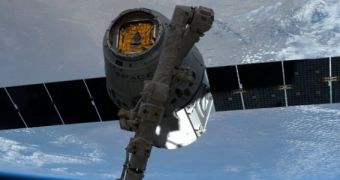On Friday, April 18, Hawthorne, California-based Space Exploration Technologies Corporation (SpaceX) successfully launched its third resupply flight to the International Space Station (ISS). The mission was carried out by a Dragon spacecraft, which flew into space aboard a Falcon 9 medium-lift delivery system. Both vehicles are built and operated by SpaceX.
Launch occurred at 15:25 EDT (1925 GMT) from Space Launch Complex 40 (SLC-40) at the Cape Canaveral Air Force Station (CCAFS) in Florida. This was the third resupply flight the unmanned Dragon capsule flew under the terms of a $1.6 billion (€1.14 billion) Commercial Orbital Transportation Services (COTS) contract between NASA and Space X. The mission is designated CRS-3.
Among the 2.5 tons of cargo loaded onto the private spacecraft are around 150 scientific experiments, to be conducted by members of Expedition 39 and Expedition 40 aboard the ISS. At a glance, these experiments include setups meant to test how plants grow in space, how the human immune system works under the stress of microgravity, and so on.
Also aboard the Dragon is a technology demonstrator for a new laser optics communication system, a device similar to the Lunar Laser Communication Demonstration (LLCD) pulsed laser system aboard the former NASA Lunar Atmosphere and Dust Environment Explorer (LADEE) spacecraft. Earth observation payloads are also included in the manifest.
Another important cargo is a pair of legs that will go on Robonaut-2, a robotic astronaut developed by NASA and General Motors and sent into space in 2011. This asset currently consists of a torso, two arms, and a head, and the pair of legs is meant to complete the original design. Soon, R2 will be used to perform time-consuming tasks, both inside and outside the ISS, freeing up the human astronauts.
The spacecraft arrived at the space station at 07:14 EDT (1114 GMT) on Sunday, April 20. Since the capsule features no automatic docking systems, Expedition 39 Commander and Japan Aerospace Exploration Agency (JAXA) astronaut Koichi Wakata used the Candarm-2 robotic arm on the ISS to grapple the Dragon as it flew past. NASA astronaut Rick Mastracchio provided support.
Dragon CRS-3 will remain docked to the space station until May 18. Over next three weeks, astronauts will remove all cargo from the capsule and will then fill it up again with around 1,560 kilograms (3,500 pounds) of unneeded experiments, tools, crew supplies, and hardware. The vehicle is scheduled to splashdown in the Pacific Ocean, just off the coasts of Baja, California.
“SpaceX is delivering important research experiments and cargo to the space station. The diversity and number of new experiments is phenomenal,” commented the associate administrator for human exploration and operations at NASA, William Gerstenmaier.
“The investigations aboard Dragon will help us improve our understanding of how humans adapt to living in space for long periods of time and help us develop technologies that will enable deep space exploration,” he said.

 14 DAY TRIAL //
14 DAY TRIAL //